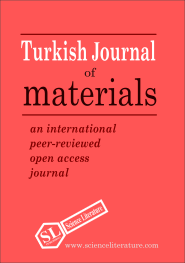Modeling of The PEM Type Fuel Cells
Abstract
Population growth, industrialization, and technological developments are increasing the energy requirement of the world every day. Currently, the energy requirement is usually provided by fossil fuels. Fossil fuels are considered to be the main source of global warming due to generating high CO2 emissions. To reduce the greenhouse gases that threaten the future of the world and humanity, focusing on preference for clean, renewable, and environmentally friendly energy sources is necessary. The intermittent and fluctuating energy production potentials of renewable energy sources require continuous and efficient storage of energy. Fuel cells which are remarkable energy storage systems due to their high specific energy density, also use clean and environmentally friendly hydrogen for energy conversion. Polymer electrolyte membrane fuel cells (PEM) also called Proton exchange membrane (PEM) fuel cell is the most common type of fuel cells. This study modeled PEM fuel cells modeled in MATLAB/Simulink program. The voltage losses, power, and voltage densities of the system were analyzed.
Full Text:
PDFReferences
A. S. Reyhan and H. Reyhan, “New Assessments on the Causes, Consequences, Solutions of Global Warming,” Memleket Siyaset Yönetim (MSY), vol. 11, no. 26, pp. 1–24, 2016.
UNFCCC, 'Kyoto Protocol - Targets for the first commitment period', 2011, [Online] Available: https://unfccc.int/process-and-meetings/the-kyoto-protocol/what-is the-kyoto-protocol/
TÜİK, "Greenhouse-Gas-Emissions-Statistics, 2019," [Online] Available: https://data.tuik.gov.tr/Bulten/Index?p=Greenhouse-Gas-Emissions-Statistics-1990-2020-45862.
UNFCCC, “Nationally determined contributions under the Paris Agreement: Synthesis report by the secretariat,” English, no. September, pp. 1–42, 2019, [Online] Available: https://unfccc.int/documents?search2=&search3=United%20National%20Framework%20Convention&f%5B0%5D=document_type%3A4171&order=created&sort=desc&page=%2C%2C29.
C. Turan, Ö. N. Cora, & M. Koç, Contact resistance characteristics of coated metallic bipolar plates for PEM fuel cells–investigations on the effect of manufacturing. international journal of hydrogen energy, voli 37, no.23, pp. 18187-18204, 2012
M. E. Şahin, “An Efficient Solar-Hydrogen DC-DC Buck Converter System with Sliding Mode Control,” El-Cezeri Fen ve Mühendislik Derg., vol. 2019, no. 3, pp. 558–570, 2019.
T. N. Veziroǧlu and S. Şahin, “21st Century’s energy: Hydrogen energy system,” Energy Convers. Manag., vol. 49, no. 7, pp. 1820–1831, 2008,
M. E. Şahin, H. I. Okumuş, and M. T. Aydemir, “Implementation of an electrolysis system with DC/DC synchronous buck converter,” Int. J. Hydrogen Energy, vol. 39, no. 13, pp. 6802–6812, 2014,
M. E. Şahin, "Designing an electrolyses system with DC/DC buck converter". MSc. Thesis. Gazi University, Institute of Science and Technology, 2006.
G. Şefkat and M. A. Özel, “Simulink Model and Analysis of PEM Fuel Cells" Uludağ Univ. J. Fac. Eng., vol. 23, no. 2, pp. 351–366, 2018.
M. Hasanzadeh, N. Shadjou, and M. Marandi, “Graphene quantum dot functionalized by chitosan and beta-cyclodextrin as a new support nanocomposite material for efficient methanol electrooxidation,” J. Alloys Compd., vol. 688, pp. 171–186, 2016.
S. J., Peighambardoust, S. Rowshanzamir, & M. Amjadi, “Review of the proton exchange membranes for fuel cell applications,” Intern. journal of hydrogen energy 35(17), pp. 9349-9384, 2010.
P. Mukoma, B. R. Jooste, & H. C. M. Vosloo, “Synthesis and characterization of cross-linked chitosan membranes for application as alternative proton exchange membrane materials in fuel cells, ” Journal of Power Sources, vol. 136, no.1, 16-23, 2004.
Colleen Spiegel, PEM Fuel Cell:Modeling and Simulation using MATLAB, Elsevier, 2008.
J. Lobato, H. Zamora, J. Plaza, P. Cañizares, and M. A. Rodrigo, “Enhancement of high-temperature PEMFC stability using catalysts based on Pt supported on SiC based materials,” Appl. Catal. B Environ., vol. 198, pp. 516–524, 2016.
Y. Lu, S. Du, and R. Steinberger-Wilckens, “One-dimensional nanostructured electrocatalysts for polymer electrolyte membrane fuel cells—A review,” Appl. Catal. B Environ., vol. 199, pp. 292–314, 2016.
F. A. Zakil, S. K. Kamarudin, and S. Basri, “Modified Nafion membranes for direct alcohol fuel cells: An overview,” Renew. Sustain. Energy Rev., vol. 65, pp. 841–852, 2016.
K. Kendall, A. Dhir, and I. Staffell, “Hydrogen Fuel Cell Battery Electric Vehicles (HFCBEV) vs. Battery Electric Vehicles (BEV)-A Birmingham Experience,” May 2014, 2010.
C. Gibson, “Nexa Manual,” p. 114, 2003. [Online] Avaliable: http://faculty.stust.edu.tw/~wcchang/MAN5100078.pdf, 2019.
H. Vaghari, H. Jafarizadeh-Malmiri, A. Berenjian, and N. Anarjan, “Recent advances in application of chitosan in fuel cells,” Sustain. Chem. Process., vol. 1, no. 1, pp. 1–12, 2013.
U. M. Karaoğlan, N. S. Kuralayi "Model of PEM Fuel Cell" Mühendis ve Makina, vol. 55, no 657, pp.51-58, 2014.
Ö. Çamcı, "Application of the Fuel Cell ın Motor Vehıcles, " MSc. Thesis., Yıldız Technical University, Institute of Science and Technology, 2005.
Copyright (c) 2019 Turkish Journal of Materials

This work is licensed under a Creative Commons Attribution-NonCommercial 4.0 International License.
Indexing:









